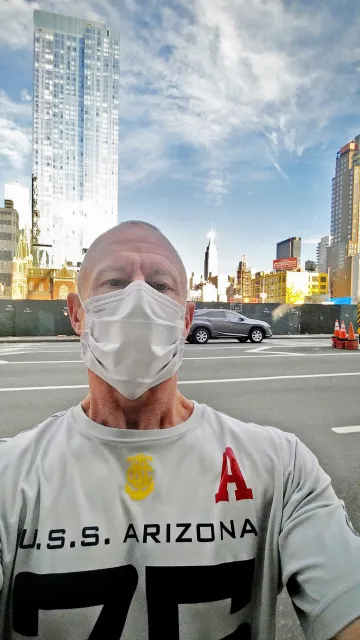Learning Curve
Saving lives at home and abroad
Brad Butler ’90 ’94 has an insatiable hunger for new experiences and endless learning. And for wounded soldiers, COVID-19 patients and members of the Phoenix community, that’s a very good thing.

In this selfie, Brad Butler wears his Arizona colors in New York City.
When we caught up with this energetic doc, he was fresh off a three-week stint at New York’s Jacob K. Javits Convention Center. The center, normally home to trade shows and corporate galas, had been transformed into a temporary 3,000-bed field hospital for COVID-19 patients. A Navy reservist, Butler had been dispatched under the Defense Support of Civil Authorities program. Commonly known as DSCA, the program allows military personnel to work alongside civilians in times of crisis.
Along with the temporary facility in the Javits Center, the 1,000-bed Navy hospital ship Comfort was brought to New York Harbor to help fight the pandemic.
“There were literally thousands of military medical personnel who descended upon New York City,” says Butler, who also is an associate professor of emergency medicine at the University of Arizona College of Medicine – Phoenix.
“It was probably the largest military medical mission in the history of the world. We made a difference right at the peak.” Nearly 1,500 patients were treated in Javits and on the Comfort, relieving pressure on local hospitals, where patients had previously languished in hallways or emergency rooms.
Butler thrives on that kind of intensity. He not only works in the emergency room at Phoenix’s Maricopa Medical Center but also has shipped off to combat-zone hospitals in Iraq and Afghanistan.
“The military has shown me the most amazing medicine I will ever experience,” he says. “When I was deployed to Kandahar, Afghanistan, I was in a level-one trauma center. My first patient was a teenage Afghan boy who had stepped on a pressure plate [bomb] and had his legs blown off. That was my initiation to wartime trauma.”
Another time, he witnessed medics treating a 22-year-old Army first lieutenant “who came in essentially dead. His neck was cut to put a breathing tube in because they couldn’t intubate him. He was getting CPR, and I watched his chest get opened up. His aorta was clamped, and epinephrine was injected directly into his heart.
“A few months later, I saw him on a YouTube video doing 50 pushups.”
The pandemic has brought Butler another intense learning curve. His experience in New York convinced him that, with proper precautions, medical personnel can safely treat COVID-19 patients — but only with a rigorous safety regimen like the one he faced daily at the Javits Center.

Makeshift hospital rooms along the floor at New York City’s Javits Center, March 27, 2020. / Anthony Behar/Sipa USA via AP Images
“First, they would have a corpsman or a medic spray my hands off, and then point me towards the gown. I would put my gown on, and they would spray my hands down again and point me towards the mask. They would make sure that I had put the on mask correctly. Then they would spray my hands again and tell me to put on my eye protection. They would spray my hands again, and they would tell me to get some gloves. Only then was I allowed to walk in.”
The process was meticulous but essential. “The floor, every surface you touched, every patient that you interacted with was COVID-19 positive,” Butler says. “The virus was everywhere, but I didn’t have one ounce of fear. I knew that I had put on all the equipment that I needed.”
Less than one percent of the medical staff was infected by the coronavirus, he says.
Butler traces his passion for learning back to his time at the University of Arizona. He’s a fourth-generation Wildcat who volunteers with the Wildcat Mentor Society and serves on the governing board of the Arizona Alumni Association.
“I’ve only missed two Homecomings since 1985, and that was when I was deployed to Iraq and Afghanistan,” he says. “I bleed red and blue.”
